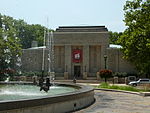Indiana University Auditorium
Indiana University BloomingtonIndiana building and structure stubsPerforming arts venues in Indiana

Indiana University Auditorium (IU Auditorium), is a 3,200-seat performing arts venue located at Indiana University in Bloomington, Indiana. It is situated in IU's Fine Arts Plaza alongside the Lilly Library and the Eskenazi School of Art, Architecture + Design. Construction on IU Auditorium began in 1939 as a part of the Federal Works Agency Projects. It officially opened its doors March 22, 1941. Today, IU Auditorium presents Broadway touring acts, popular musical artists, comedians, classical musicians and more. Over the years, it has hosted many notable artists, including Frank Zappa, James Taylor, Rush, Chicago, John Mellencamp, LL Cool J and The Go-Go's.
Excerpt from the Wikipedia article Indiana University Auditorium (License: CC BY-SA 3.0, Authors, Images).Indiana University Auditorium
East 7th Street, Bloomington
Geographical coordinates (GPS) Address External links Nearby Places Show on map
Geographical coordinates (GPS)
| Latitude | Longitude |
|---|---|
| N 39.168472222222 ° | E -86.518194444444 ° |
Address
IU Auditorium
East 7th Street 1211
47405 Bloomington
Indiana, United States
Open on Google Maps




